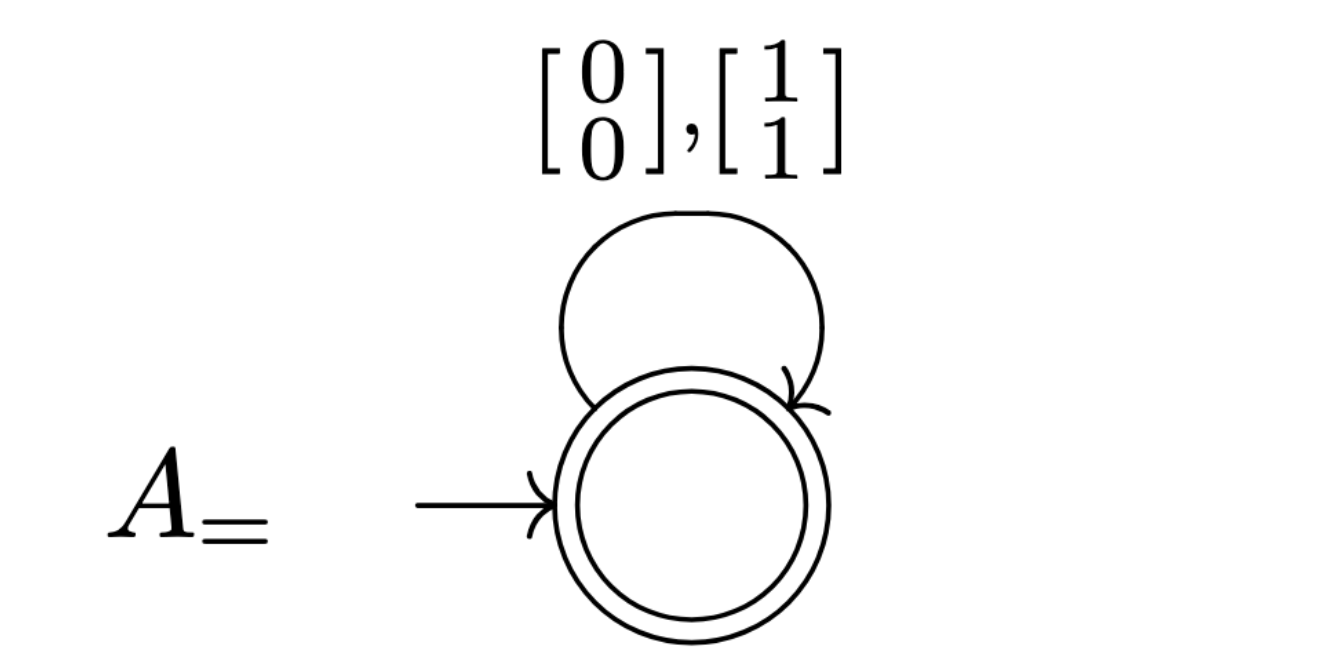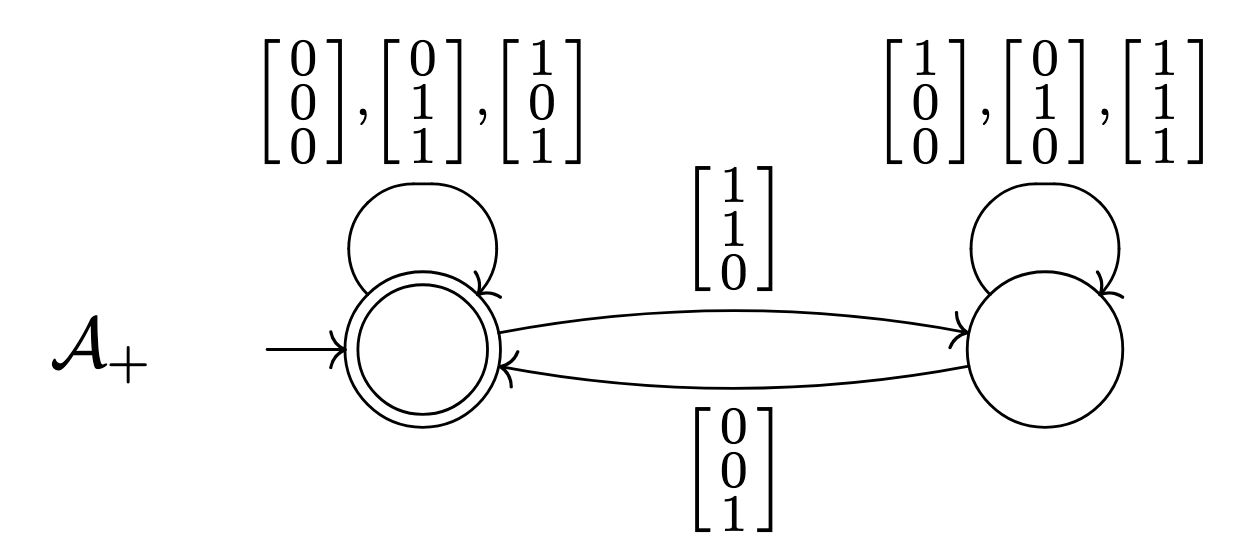Notes - Logic and Proof MT24, Presburger arithmetic
Flashcards
@Define Presburger arithmetic.
The theory of the structure $(\mathbb N, 0, 1, +, <)$ under the intended interpretation.
@State a decidability result about Presburger arithmetic.
is decidable.
@Prove that Presburger arithmetic is decidable.
It suffices to show that $\text{Th}(\mathbb N, 0, 1, +)$ is decidable, since any formula over $(\mathbb N, 0, 1, +, <)$ can be rewritten as a formula using $+$ and $=$ that defines the same property on $\mathbb N$ (note that formulas can only express finite or cofinite sets, which can be represented over the weaker signature by just listing elements contained in the set, or elements not contained in the set).
To show this is decidable, we reduce determining whether a statement is satisfiable to membership of a specific word in a regular languages.
Consider a quantifier-free formula $F$ over variables $x _ 1, \ldots, x _ n$ and consider the corresponding alphabet
\[\Sigma_n = \\{ \begin{bmatrix} 0 \\\\ 0 \\\\ \vdots \\\\ 0 \end{bmatrix}, \dots, \begin{bmatrix} 1 \\\\ 1 \\\\ \vdots \\\\ 1 \end{bmatrix} \\}\]which represents a valuation of these variables using little endian, where the value of $x _ i$ corresponds to the $i$-th row of the vector.
Define $A _ =$ representing the subset of $\Sigma _ 2^\ast$ where the elements satisfy $x _ 1 = x _ 2$ by the DFA:

And define $A _ +$ representing the subset of $\Sigma _ 3^\ast$ where the elements satisfy $x _ 1 + x _ 2 = x _ 3$ by:

We now define $A _ F$ by induction on the structure of $F$. Define
\[\pi_{} : \begin{bmatrix} x_1 \\ x_2 \\ \vdots \\ x_n \end{bmatrix} \mapsto \begin{bmatrix} x_i \\ \vdots \\ x_k \end{bmatrix}\]- Base case: $x _ i = x _ j$, take $A _ F$ to be the DFA for the language defined by $\pi _ {i, j}^{-1}(L(A _ =))$, which is valid as regular languages are closed under inverse homomorphisms.
- Base case: $x _ i + x _ j = x _ k$, take $A _ F$ to be the DFA for the language defined by $\pi _ {i,j,k}^{-1}(L(A _ +))$.
- Case: $F = F _ 1 \wedge F _ 2$. Take $A _ F$ to be an automaton whose language is $L(A _ {F _ 1}) \cap L(A _ {F _ 2})$.
- Case: $F = \lnot G$. Take $A _ F$ to be an automaton whose language is $\Sigma^\ast _ n \setminus L(A _ G)$.
This covers all quantifier-free formulas.
Now consider a sentence
\[Q_1 x_1 \cdots Q_n x_n F\]in prenex form. For $k = 0, \ldots, n$ we write $F _ k := Q _ {k+1} x _ {k+1} Q _ n x _ n F^\ast$ an define a corresponding automaton $A _ k$ over alphabet $\Sigma _ k$ such that $A _ k$ accepts the set of values of variables $x _ 1, \ldots, x _ k$ that satisfy $F _ k$. An invariant is that $A _ k$ has non-empty lanugage iff formula $F _ k$ is satisfiable.
Take $A _ n$ to be $A _ F$.
Now suppose that $F _ {k-1} = \exists x _ k F _ k$. By induction, $A _ k$ is an automaton on an alphabet $A _ k$ corresponding to $F _ k$. Define $A _ {k-1}$ to be an automaton whose lanugage is $\pi(L(A _ k))$ where $\pi : \Sigma _ k \to \Sigma _ {k-1}$ is the map that projects out the $k$-th coordinate of each tuple in $\Sigma _ k$.
Handle the universal quantifier $\forall x _ k$ by treating it as shorthand for $\lnot \exists x _ k \lnot$.
We end up with an automaton $A _ 0$ for the sentence $F _ 0$ over the alphabet $\Sigma _ 0$. This automaton has non-empty lanugage iff $(\mathbb N, +, 0, 1)$ satisfies $F _ 0$.